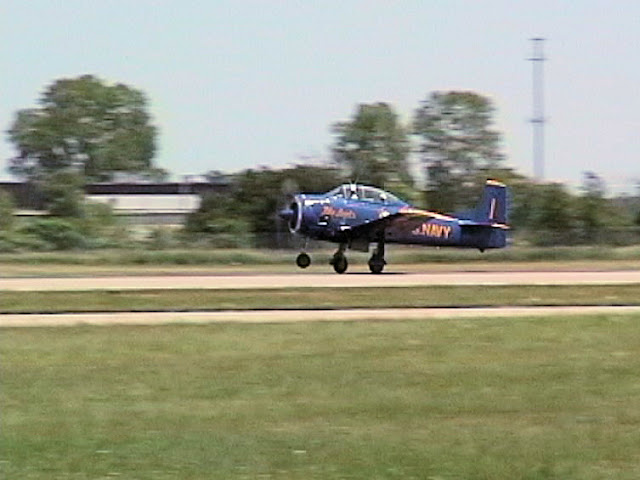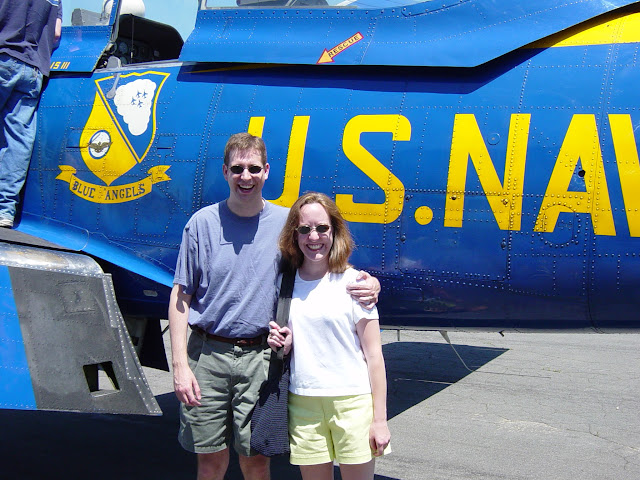My ride was in the Air Zoo's North American T-28 Trojan. After World War II, the T-28 replaced the T-6 Texan as a trainer for the Navy and Air Force. It was meant to transition pilots into jets and, as a result, was the first military trainer built with tricycle gear. It is powered by a nine-cylinder radial engine (Wright R-1820-86 Cyclone) developing 1,425 horsepower.
 |
| Video / Photo by Kristy |
On tours, astute museum visitors often ask if the Blue Angels livery on the aircraft is authentic. Well...yes and no. The Blue Angels never flew T-28s. However, a former owner of the aircraft was a big fan of the Blue Angels and obtained their permission to outfit the T-28 with an accurate Blue Angels paint scheme. Thus, the paint job is authentic. It just doesn't belong on the T-28! But it's a beautiful paint job and the museum has not seen fit to redo it.
 |
| Video / Photo by Kristy |
My ride was to be a part of the Air Zoo's Flight of the Day, where a brief demonstration flight is performed for museum guests.
At 2:00 on the afternoon of the appointed day, I met with the pilot, Dan Hamill. Dan gave me a brief overview of the routine he would fly before we went out to the ramp. Unfortunately, because of the nature of the routine, I would not be receiving any stick time.
As I was climbing into the back seat of the trainer, museum visitors were brought out onto the ramp where they could witness the starting of a radial engine up close and personal. Noticing that Kristy had a video camera to capture the event, Ron from the Air Zoo positioned her in front of the aircraft where she could get some nice footage of the start up.
 |
| Video / Photo by Kristy |
I strapped myself in and donned a rather non-stylish white helmet (remember the helmets from "Spaceballs"?). As a trainer, the T-28 has a full instrument panel available in the back seat where an instructor would usually sit. I set the altimeter to the field elevation for Kalamazoo so that I could keep track of what was going on.
It was a hot day without a cloud in the sky. Dan warned me that he would leave the canopy open until the takeoff roll to keep from baking us both. No stranger to taxing around on hot days with the Cessna's door open, it sounded like a good idea to me.
Dan engaged the electric starter and the large prop began to turn slowly. The engine coughed a few times before suddenly catching with a puff of white smoke. Once he had the engine running smoothly, Dan contacted the tower and told them what we were planning. The tower noted that there was no one in the pattern and no commercial jet traffic expected anytime soon. "The airport's all yours," the tower controller finished. There's something very cool about receiving carte blanche from air traffic control while at the controls of a warbird.
 |
| Video / Photo by Kristy |
Once cleared to depart, we took the runway and Dan closed the canopy. The instant greenhouse made things rather uncomfortable until we built up enough speed for the airvents to become effective. After climbing to pattern altitude, Dan made a tight right turn into a downwind for runway 35. I was amazed at the visibility afforded by the bubble canopy.
We lined up on approach and made our first pass along runway 35. Glancing at the instruments, I noted that we were flying at 200 knots (230 mph) about 100 feet off the runway surface. The museum flew past in a blur. Once we cleared it, Dan warned me that he was about to break to the left.
 |
| Video / Photo by Kristy |
"Ok," I acknowledged, but I had no idea what was coming. The moment I responded, Dan initiated a knife-edge, climbing turn to the left. I felt like I was being crushed; like trying to wear an elephant as a hat. From the outside, I'm sure it was a crowd-pleaser.
 |
| Video / Photo by Kristy |
"That was a 4-g turn," Dan commented matter-of-factly. As a seasoned military pilot, four g's were nothing to Dan. To an aerobatic newbie who tried to draw a breath of air right when the pull began, it was a bit overwhelming (but still WAY cool).
We made a gentle turn on to a left base for runway 35, directly over my office, then made a second low pass ending with a less-aggressive break to the right. Then, we lined up on runway 35 one last time and Dan executed a perfect (as far as I could tell) landing.
We taxied back and were met by our ground crew. As I removed my helmet, I could hear applause from the crowd.
 |
| Photo by Kristy |
 |
| Photo by Ron |
It didn't last long, but it was quite a ride!
